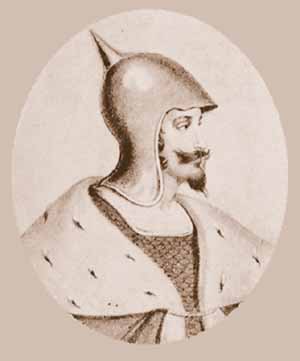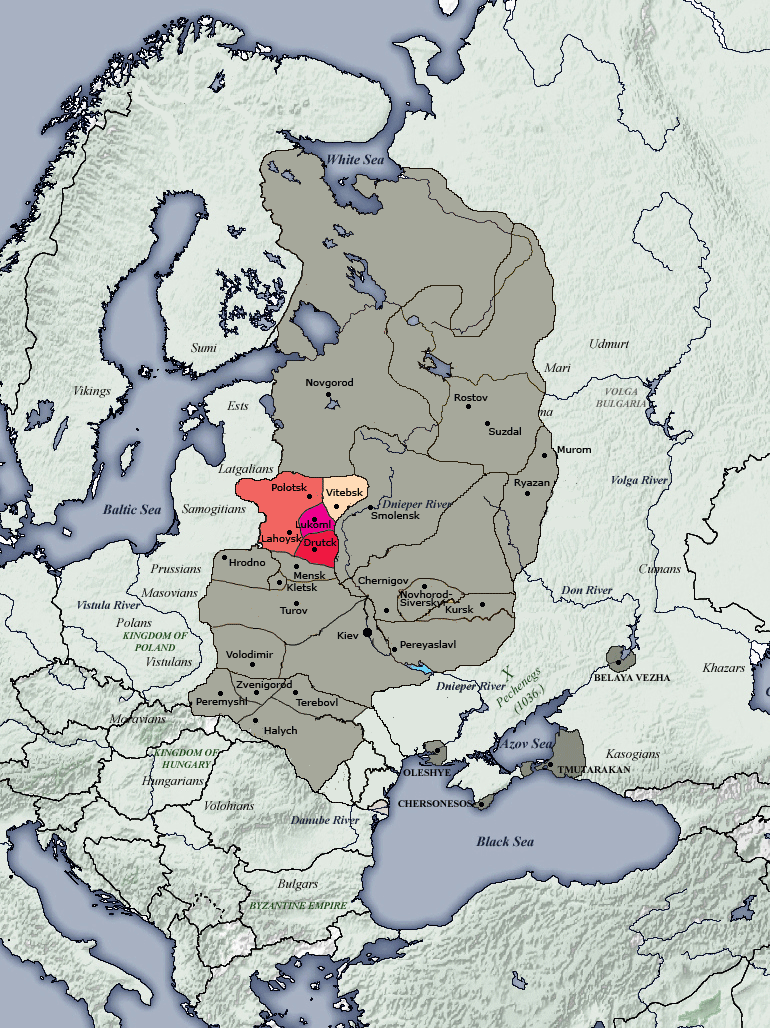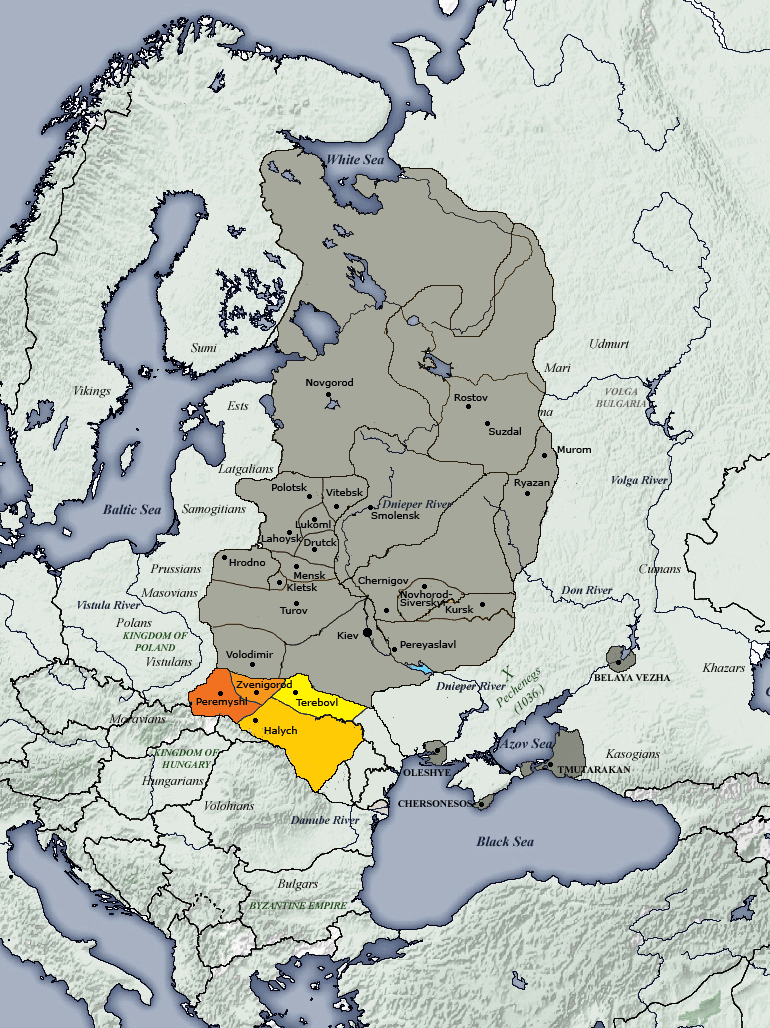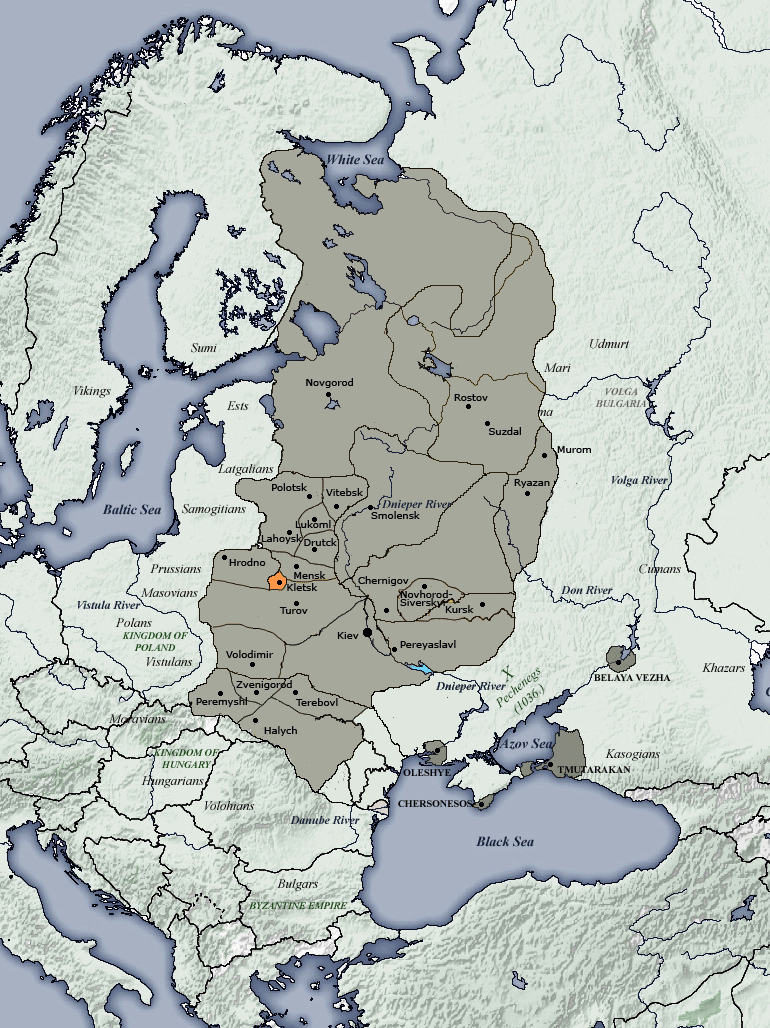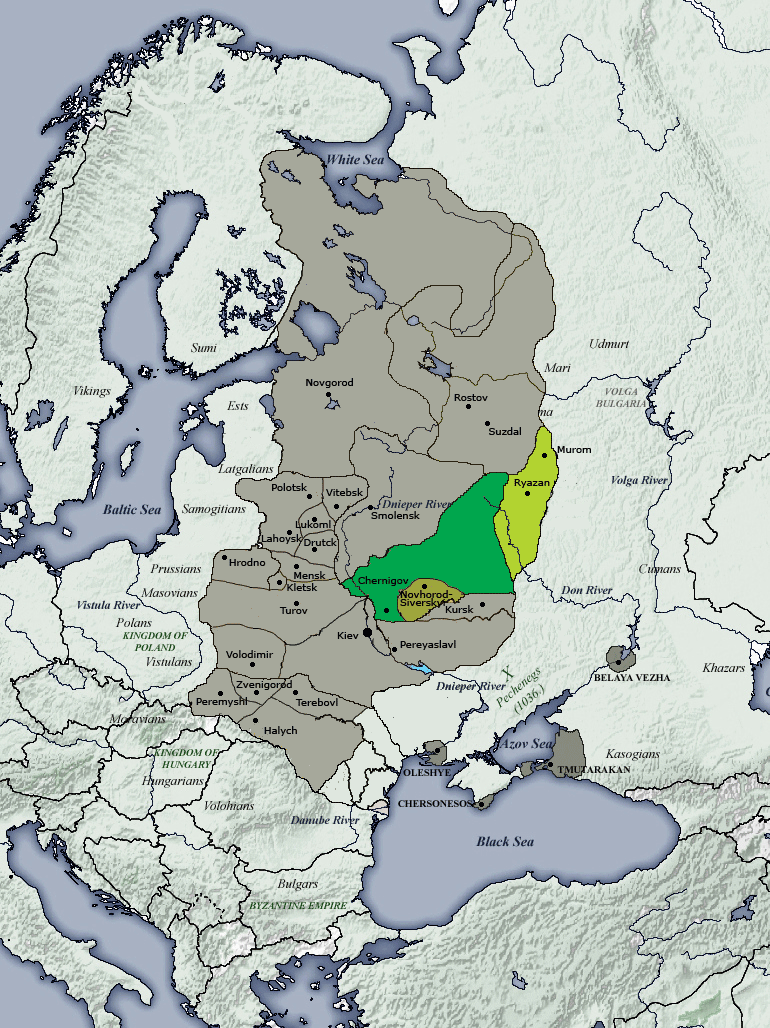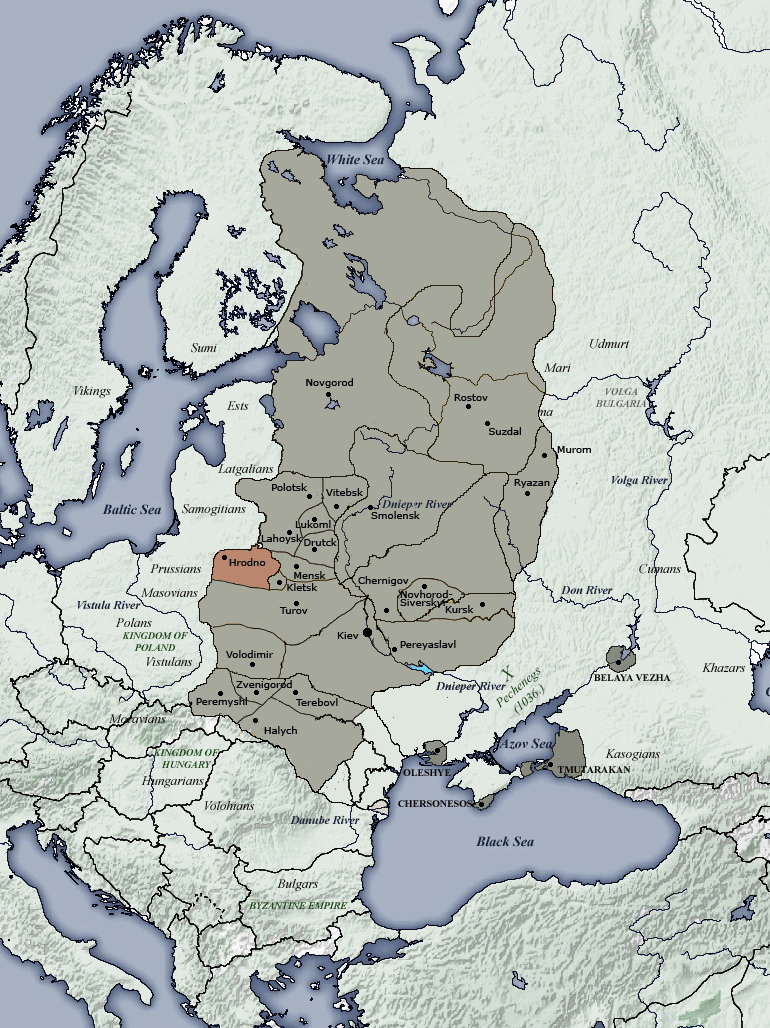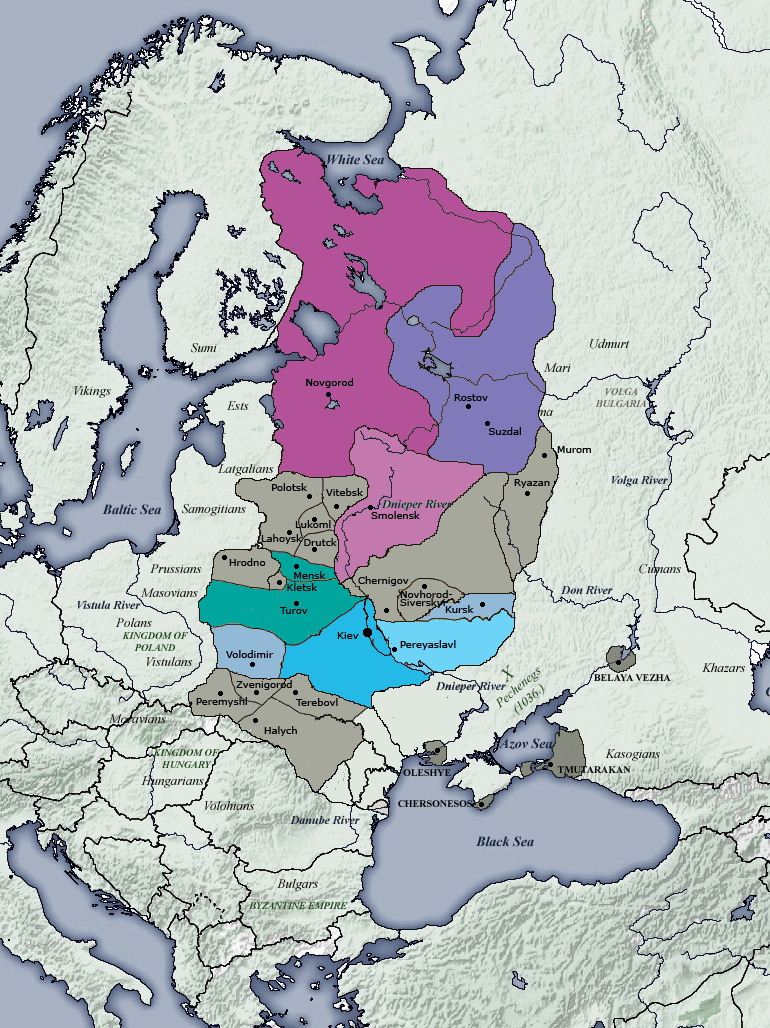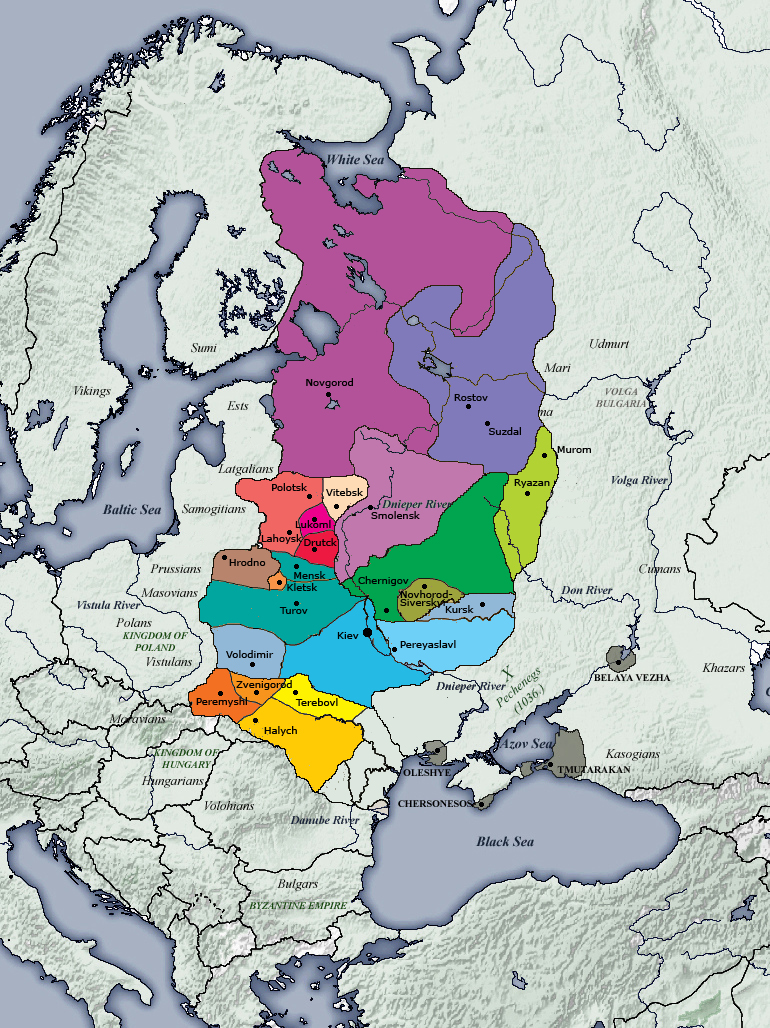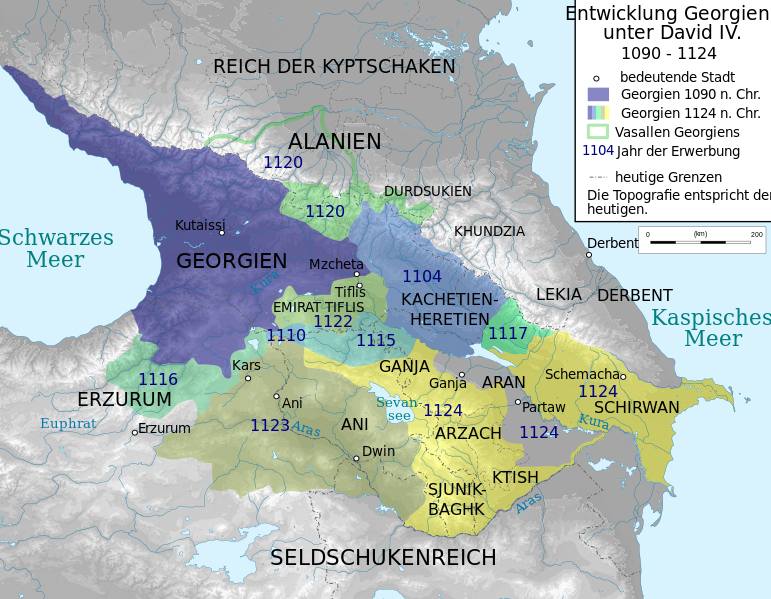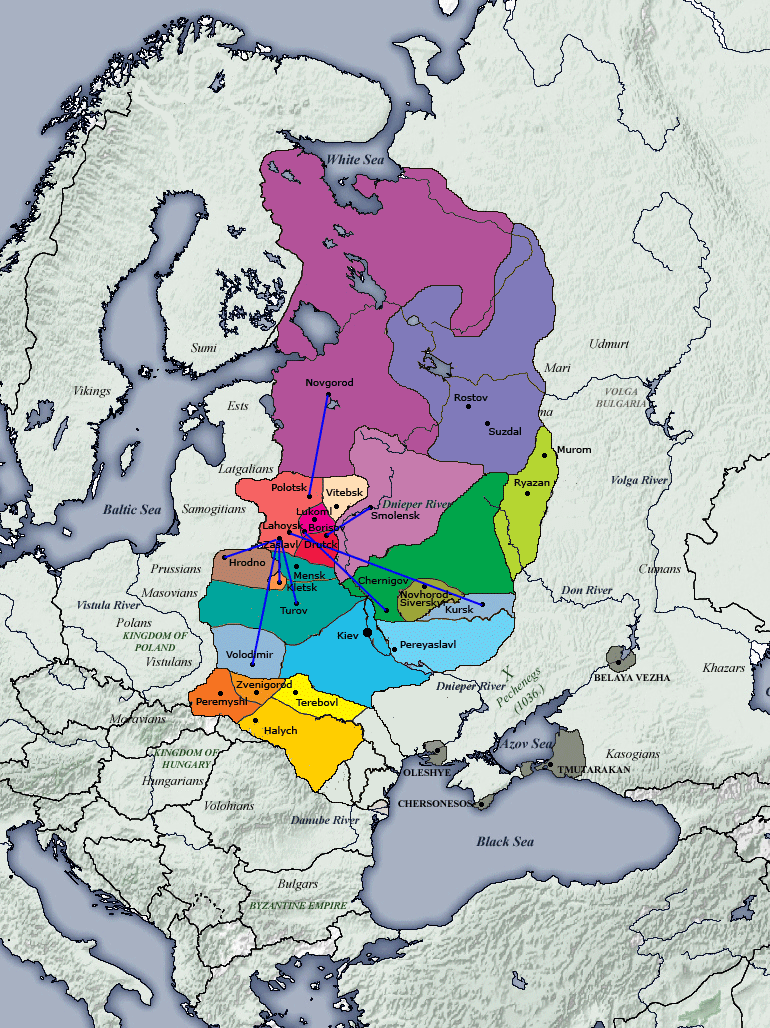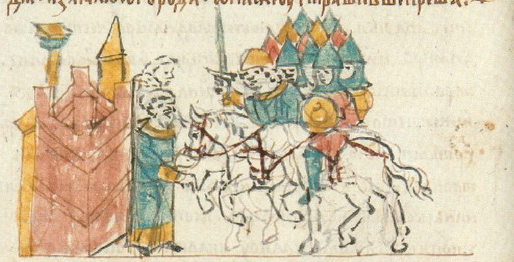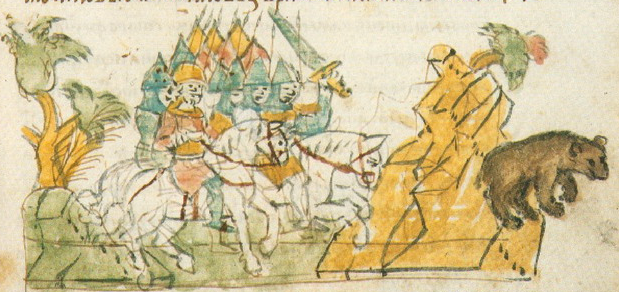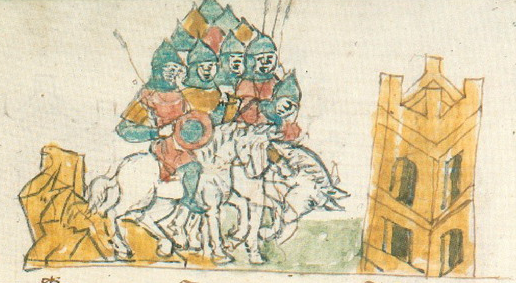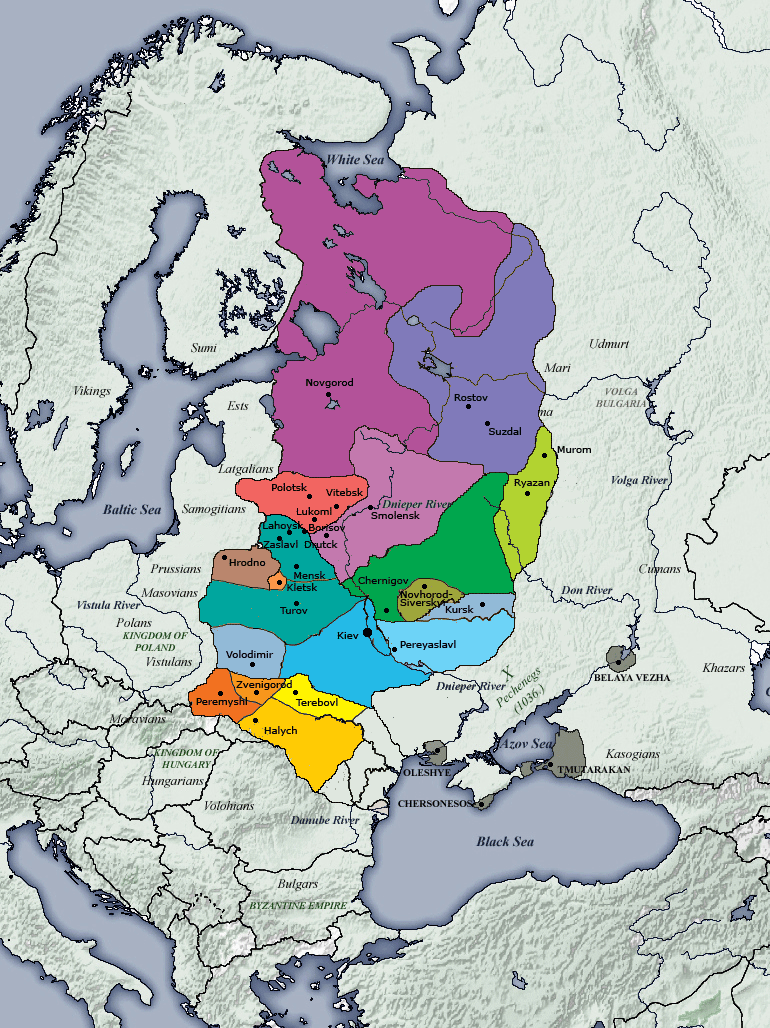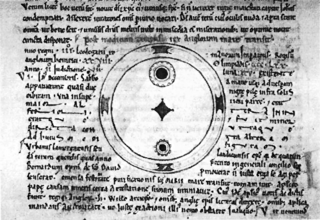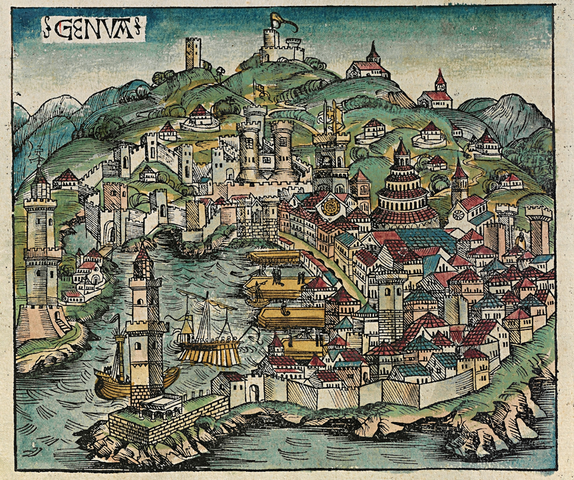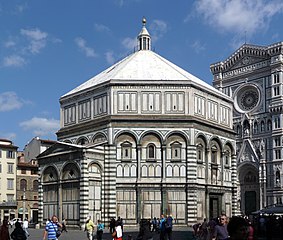Chapter Two. Year 6636 (1128)
Mstislav the Great planned the campaign for year 6636 with two main goals: to help Byzantium against Hungary and to crash the last powerful tribe (or horde) of cumans.
But the weather was too bad.
In the autumn, 6635 the winter came too early and winter crops were frost. The spring 6636 was cold, the snow melted away only in May, then flood destroyed both crops and houses. The famine begun, and then the epidemic begun. Even rich people died – the grandson of Mstislav the Great, the governor of Novgorod, the abbot of the large monastery…
Mstislav was not able to start the campaign. He sent his messenger to Byzantium, and the emperor waited for the next year.
Rus' sources mention that in 1128 Sevinch, son of Khan Boniak, expressed the desire to plant his sword "in the Golden gate of Kiev" as his father had done before him
Sbiten was first mentioned in Slavonic chronicles in 1128
Spain
Portuguese forces led by Afonso Henriques defeated forces led by his mother Teresa of Portugal and her lover Fernão Peres de Trava on 24 June, 1128. Following São Mamede, the future king styled himself "Prince of Portugal".
The Santiago de Compostela cathedral was consecrated in 1128 in the presence of king Alfonso IX of Leon.
England
The earliest sunspot was drawing in 1128, by John of Worcester.
France
Angouleme Cathedral finished in 1128.
Flanders
Charles the Good, the childless Count of Flanders, was murdered on 2 March 1127, creating a local succession crisis. Louis VI of France marched into Flanders at the head of an army and on 30 March got the barons of the province to accept William as their new count. Initially, William did well, securing most of the county by the end of May.
This development potentially threatened Normandy, and Henry I of England began to finance a proxy war in Flanders, promoting the claims of William's Flemish rivals. Thierry of Alsace, the brother of Simon I, Duke of Lorraine, and the uncle of Dirk VI, Count of Holland, claimed the county of Flanders as grandson of Robert I.
English money and the emergence of a rival in Thierry of Alsace led to a deterioration in William's position. In February 1128 Saint-Omer and Ghent declared against him, as did Bruges in March. In May 1128 Lille too welcomed Thierry, leaving William controlling little more than the southern fringe of Flanders. Thierry's supporters came from the Imperial faction of Flanders, and upon his arrival he engaged in battle against William. Louis VI of France had Raymond of Martigné, the Archbishop of Reims, excommunicate Thierry. Louis VI then besieged Lille. In an effort to disrupt the French alliance with William, Henry I of Engalnd mounted an attack into France in 1128, forcing Louis to cut his aid to William. Louis VI was forced to retire.
However, Thierry was defeated at Tielt and Oostkamp and fled to Brugge. He was forced to flee Brugge as well, and went to Aalst. At this point William was joined by his father-in-law, Duke Godfrey of Brabant, and together their armies besieged Aalst on 12 July, with the probable intention of going on from there to reduce Ghent. The city was about to be captured when William was wounded in the arm in a scuffle with a foot soldier. The wound became gangrenous and William died at the age of twenty-five on 28 July 1128, leaving Thierry as the only claimant to the seat.
Thierry set up his government in Ghent and was recognized by all the Flemish cities as well as King Henry, who had his Flemish lords in England swear fealty to him.
Without William, the baronial opposition in Normandy lacked a leader. A fresh peace was made with France, and the King Henry I was finally able to release the remaining prisoners from the revolt of 1123, including Waleran of Meulan, who was rehabilitated into the royal court.
Meanwhile, Henry rebuilt his alliance with Fulk of Anjou, this time by marrying Matilda to Fulk's eldest son, Geoffrey. The pair were betrothed in 1127 and married on June 17, 1128. The wedding was celebrated in Le Mans. It is unknown whether Henry intended Geoffrey to have any future claim on England or Normandy, and he was probably keeping his son-in-law's status deliberately uncertain. Similarly, although Matilda was granted a number of Normandy castles as part of her dowry, it was not specified when the couple would actually take possession of them.
Germany
Civil war lasted.
In 1128 Conrad was crowned King of Italy by the Anselm V, Archbishop of Milan. Lothair took advantage of Conrad's expedition into Italy and his lack of resources by attacking the Staufens in Germany. King Lothar and Archbishop Adalbert put Speyer, which by then must have been totally surrounded by walls, under siege and it had to surrender short of starvation. The German bishops, again led by Adalbert of Mainz, excommunicated Conrad, an act that was confirmed by Honorius in a synod held in Rome at Easter (22 April 1128). Honorius also sent Cardinal John of Crema to Pisa to hold another synod that excommunicated Archbishop Anselm of Milan, who had crowned Conrad king. Conrad found little help in Italy and with Honorius’ support, Lothair was able to keep his throne.
In 1125, Godfrey, duke of Lower Lorraine supported Conrad of Hohenstaufen, the duke of Franconia, against Lothair of Supplinburg. In 1128 Lothair withdrew the duchy of Lower Lorraine and granted it to Waleran of Limburg , the son of Henry, whom Henry V had deprived in 1106. Nonetheless, Godfrey maintained the margraviate of Antwerp and retained the ducal title (which would in 1183 become Duke of Brabant).
Albert the Bear, after the death of his brother-in-law, Henry II, margrave of a small area on the Elbe called the Saxon Northern March, in 1128, disappointed at not receiving this fief himself, attacked Udo, the heir, and was consequently deprived of Lusatia by Lothar.
Henry of Groitzsch was appointed Margrave of the Saxon Ostmark
Pomerania
Lübeck was burned down in 1128 by the pagan Rani from Rügen.
Lutici: Henry's sons, Canute and Sventipolk (also Svatopluk or Zwentibold), fought over their inheritance. When Canute was killed in 1128 at Lütjenburg, Sventipolk succeeded in taking over the entire country. Vicelinus finally sent priests to Liubice, but after this was conquered by the Rani and destroyed, the priests fled to Faldera (Neumünster). Sventipolk was killed in the same year.
In 1128, Demmin, the County of Gützkow and Wolgast were already incorporated into Wartislaw I's realm, yet warfare was still going on. Captured Lutici and other war loot, including livestock, money, and clothes were apportioned among the victorious. After Wartislaw's Lutician conquests, his duchy lay between the Bay of Greifswald to the north, Circipania, including Güstrow (Ostrów), to the west, Kolobrzeg in the east, and possibly as far as the Havel and Spree rivers in the south.
These gains were not subject to Polish over lordship, but were placed under over lordship of Nordmark margrave Albrecht the Bear a dedicated enemy of Slavs, by Lothair III, Holy Roman Emperor. Thus, the western territories contributed to making Wartislaw significantly independent from the Polish dukes. Wartislaw was not the only one campaigning in these areas.
Wartislaw managed to expand his duchy westward, thereby forming the territorial body of the later Duchy of Pomerania, and organized the second visit of Otto of Bamberg in 1128.
Otto of Bamberg came on 19 April 1128, invited by duke Wartislaw I himself, aided by the emperor Holy Roman Emperor Lothar II, to convert the Slavs of Western Pomerania just incorporated into the Pomeranian duchy, and to strengthen the Christian faith of the inhabitants of Stettin and Wollin, who fell back into heathen practices and idolatry. Otto visited primarily Western Pomeranian burghs, had the temples of Gützkow and Wolgast torn down and on their sites erected the predecessors of today's St Nikolai and St Petri churches, respectively. The nobility assembled to a congress in Usedom, where they accepted Christianity on June 10, 1128.
Otto aborted the mission in November 1128 on behalf of the emperor, after he had sought to mediate the conflicts between the Pomeranian and Polish dukes
Hungary
Stephen was "sickly in body and was recuperating someplace in the midst of his land", according to John Kinnamos. The Illuminated Chronicle said that his illness was so serious that "all expected his death." The chronicle added that "traitors" went so far as to elect two kings, the "Counts Bors and Ivan". Upon regaining his health, Stephen had Ivan executed and expelled Bors from his kingdom.
Italy
In the twelfth century Gaetan trade expanded, while the duchy's Norman dukes took less interest in the city itself. In 1128 Gaeta is recorded as baying less, only twelve denarii, for docking a ship at Genoa than any other city (Amalfi, Naples, Rome, or Salerno), perhaps suggesting longstanding relations with Genoa.
In 1128, members of the Athen family, perhaps seeking to usurp the throne of Sardinia, or perhaps just the regency, made an attempt to harm the young Gonario II of Logudoro. His regent, Ittocorre Gambella, quickly whisked him away to Porto Torres and the protection of the Pisans, who took him to Pisa and the house of Ugo da Parlascio Ebriaco.
Lighthouse of Genoa was built around 1128.
Florence Baptistery was finished in 1128.
In July 1127, Duke William II of Apulia died. Count Roger II of Sicily believed that the duchy passed to him. However, this was opposed by many of the largely Norman nobility on the mainland, and in this they had the support of Pope Honorius II. Honorius stated that William had left his territory to the Holy See. A rallying-point for this opposition might have been the only other independent prince in southern Italy, Count Jordan of Ariano, but he also died on 12 August 1127. His heir was the short-lived Prince Jordan II but, on his death in November, his son Robert II of Capua became Prince. His leading lord was Ranulf of Alife.
Honorius received word that Roger had landed in Italy. He rushed to Benevento to prevent the local Normans from reaching an agreement with Roger. Roger in the meantime had rapidly overrun the duchy of Apulia and had sent Honorius lavish gifts, asking the Pope to recognise him as the new duke and promising to hand over Troia and Montefusco in exchange. Honorius, fearing the expansion of Norman power to the south under one dominating ruler, threatened to excommunicate Roger if he persisted. In the meantime, many of the local Norman nobles, fearful of Roger’s power, allied themselves with Honorius, as Honorius formally excommunicated Roger in November 1127. Roger left his armies threatening Benevento, while he returned to Sicily for reinforcements.
In December, Honorius visited Capua, a longtime papal ally, and there organised the resistance to Roger's claim, recruiting both Ranulf and Robert to his cause. He promised them that all who took part in the campaign against Roger would earn remission of their sins. On 30 December 1127, Honorius preached a crusade against Roger II after having anointed Robert as Prince of Capua.
Robert's leadership was less than stellar and Ranulf was soon the effective military leader of the opposition. When Roger arrived on the peninsula with an army, Ranulf tried to organise resistance, especially in Troia, but gave up when Roger threatened to invade his lands.
Roger returned in May 1128 and continued to harass papal strongholds while avoiding any direct confrontation with Honorius’ forces. In July 1128, the two armies came in contact with each other on the banks of the Bradano, but Roger refused to engage, believing that the papal armies would soon fall apart, and soon enough some of the Pope’s allies began deserting to Roger. Trying to salvage something of the situation, Honorius sent his trusted advisor Cardinal Aymeric together with Cencio II Frangipane to negotiate with Roger secretly. Honorius agreed to invest Roger with the duchy of Apulia in exchange for an oath of faith and homage by Roger.
Honorius travelled to Benevento, and after safeguarding the interests of Robert of Capua, he met Roger on the Pons Major, the bridge which crosses the Sabbato river near Benevento, on 22 August 1128. There, he formally invested Roger with the duchy of Apulia and both agreed to a peace between the Kingdom of Sicily and the Papal States. Unfortunately, Honorius had just returned to Rome when he was informed that the nobles of Benevento had overthrown and killed the rector (or papal governor) of the city and established a Commune. Furious, he declared he would wreak a terrible vengeance on the city, whereupon the residents asked Honorius for forgiveness and to send another governor.
East
Jerusalem
Stephen of La Ferté was Latin Patriarch of Jerusalem from 1128 until his death in 1130. He was a French priest, abbot of Saint-Jean-en-Vallée at Chartres, and related to Baldwin II, King of Jerusalem.
His predecessor, Warmund, had been a close ally of Baldwin, but Stephen was much less ready to cooperate, reviving claims made by Patriarch Dagobert for church power. He sought to revive an agreement in 1100 between Dagobert and Godfrey of Bouillon, the first ruler of Jerusalem, for possession of Jaffa as an autonomous possession, and even of Jerusalem itself. Baldwin would not agree, and relations between the court and the patriarchate grew worse and worse.
Antioch
The Latin Patriarch of Antioch placed an interdict over the County of Edessa.
In 1128, Roger II invaded and conquered Taranto, claiming it as the heir of William II of Apulia. Being away, Bohemond could do nothing to prevent this. That year, Baldwin II marched north to mediate in the dispute, and Joscelin abandoned his claims. Meanwhile, the atabeg Zengi consolidated his power over Aleppo and Mosul.


